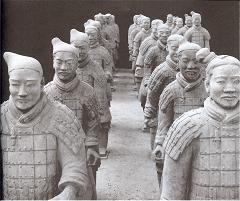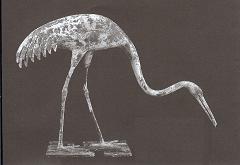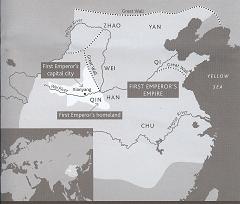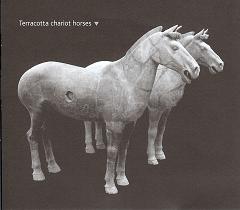|
|
|||
| Terracotta Army | |||
| About Us | Vegetable garden | Fruit garden | Flower garden | Chicken diary | Recipes | Chick originals | |||
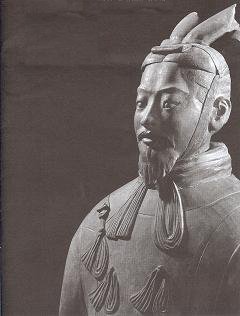 On
23 January 2008, I visited the Terracotta Army exhibition at The British
Museum. On
23 January 2008, I visited the Terracotta Army exhibition at The British
Museum.
It was absolutely fascinating so I thought I'd share some of the knowledge I gleaned here: On loan from the Museum of the Terracotta Army, the British Museum was displaying a dozen soldiers from the First Emperors collection. In all, 120 objects were on display. The soldiers and other exhibits on display came from the tomb of Qin Shihuangdi, the First Emperor of the Qin Dynasty. There were soldiers of different ranks, each with their own distinct facial features, acrobats, bureaucrats, musicians and bronze birds. Showing the wealth of artistry and creative talent that was employed by the Emperor, the terracotta characters and soldiers are utterly unique.
The First Emperor is believed to have been one of the world's greatest rulers. Over 2000 years ago he founded what was to become the nation of China. He also built a vast tomb complex, an eternal empire underground, guarded by a terracotta army. The First Emperor was born Ying Zheng in 259BC. At the age of 13
he became King of Qin - one of seven main states competing for power and
at war with each other (see map). Under his leadership Qin conquered the other states using highly developed weapons technology and military strategy. The exhibition included examples of weapons like crossbows where any parts likely to wear or break were mass developed, so they could simply be replaced as required. I don't think this army was ever without considerable fire power. After completing his campaign, the King of Qin declared himself Qin Shihuangdi: First August Divine Emperor of the Qin. To govern his empire, he introduced reforms and enforced strict laws.. He planned to join walls from conquered states to create a great wall, and built new roads and canals. Standard weights and measures, a single currency and a universal script allowed him to rule more easily. He built more than 270 palaces in his capital city Xianyang, as a display of power and to house the rulers of the states he conquered. The First Emperor wanted to govern forever and tried many potions the prolong his life. He also spent more than 30 years building his tomb complex, a palace where he could rule forever in the afterlife. At the centre of the complex was his tomb. In 1974 a farmer digging nearby found a terracotta head. He had discovered a pit of terracotta warriors.
The First Emperor's tomb itself - rumoured to contain rivers of mercury - still remains undisturbed, waiting for technology to develop which may reveal its secrets with minimal disturbance.
Life and death of the First Emperor: Hope you found this interesting!
|
|||
|

